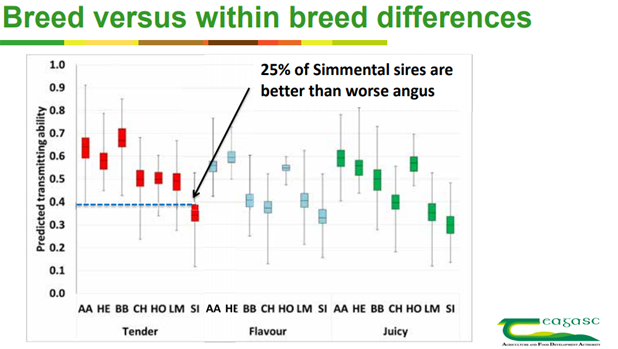
https://ec.europa.eu/eip/agriculture/en/find-connect/projects/bovine-beef-innovation-network-europe
A challenge was to try and develop a system that can identify and capture meat eating quality in beef animals and see if it can be applied across beef farms in Ireland for genetic improvement. The main task was the collection of accurate sensory data on meat eating quality in order to develop reliable genetic evaluations.
Once achieved a genetic evaluation system was launched in September 2020 for carcass and meat eating quality traits in the Irish beef cattle, although the system is still under evaluation and implementation stage. The program commenced in 2015, with almost 5,000 animals having been evaluated to date (across the full range of breeds in Ireland), for the key traits linked to carcass and meat eating quality. In addition to the standard EUROP classification data, data is also being collected on the primal cuts and the meat eating quality (i.e., tenderness, juiciness, flavour and overall liking) evaluated by trained panellists. The work will culminate in new genetic/genomic evaluations for these traits, with the ultimate goal of integrating this new information into the economic and sustainability indexes that Irish beef farmers and the industry use to breed and promote more profitable, sustainable and carbon efficient animals in the future. In that sense this program has close links with other initiative undertaken by ICBF, including the BDGP and BEEP-S.
The main objective of this program is to create a premium for beef of superior eating quality. Although eating quality is predominantly improved by production factors at farm level such as growth rate, feeding, age at slaughter, castration and by pre-and post- slaughter factors such as transport, slaughter, carcass and meat handling (ageing and packaging), 15% of the variability has been shown to be as a result of genetic diversity. Improvements in this level of diversity through genetic selection of animals with a propensity for higher meat eating quality are cumulative (increases year on year) and permanent. The figure below indicates the variation which exists within and across breeds for meat eating quality which farmers can breed for.
 Source: Berry 2019
Source: Berry 2019
Some lessons learned from the implementation of this innovation are:
1. The meat eating quality is a trait with a major interest in at consumer level, with strong emotional connection;
2. Through good scientific research it has been identified that it is possible to breed for meat eating quality;
3. Finding a fair way to economically reward stakeholders for beef quality will be a major challenge.
This innovation cover needs from several themes from BovINE Project. Identifying and breeding for superior beef eating quality will deliver higher prices and incomes, which is related to Socioeconomic Resilience. This good practice will deliver superior beef eating quality, which is within the scope of WP5 (Production Efficiency and Meat Quality). As well as breeding for superior meat eating quality, through the increased use of genetics and breeding indices at farm level, production efficiency will improve and in turn improve Environmental sustainability: WP6.
Source of information:
- Innovation submitted by the NM from Ireland: Kevin Kinsella based on an interview to Andrew Cromie, from ICBF (Irish Cattle Breeding Federation).
- Judge 2020. Breeding for superior beef meat eating quality. Conference proceeding, https://www.icbf.com/wp/wp-content/uploads/2020/01/Meat-Quality-Validation-Dr.-Michelle-Judge-Teagasc.pdf
- Berry 2019: https://www.teagasc.ie/media/website/publications/2019/Donagh-Berry-TeagascBeefConference2019.pdf